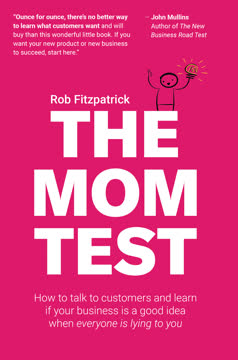Key Takeaways
1. Innovation thrives in collaborative, multidisciplinary teams
At IDEO we believe that the myth of the lone genius can actually hamper a company's efforts in innovation and creativity.
Diverse teams spark innovation. Bringing together people with different backgrounds, skills, and perspectives allows for cross-pollination of ideas and novel solutions. Hot groups form when team members are passionate about the project, face challenging deadlines, and have the freedom to experiment. These teams should be empowered to make decisions and given the resources they need to succeed.
Foster a collaborative culture. Create opportunities for spontaneous interactions and idea-sharing across disciplines. Encourage team members to build on each other's ideas during brainstorming sessions. Celebrate team achievements rather than individual accomplishments. By leveraging collective intelligence and creativity, multidisciplinary teams can tackle complex problems and generate breakthrough innovations that a lone genius might never conceive.
2. Observe real people to uncover unmet needs and inspire solutions
Innovation begins with an eye.
Watch and learn. Instead of relying solely on market research or focus groups, observe how people actually use products and services in their natural environments. Look for pain points, workarounds, and unmet needs that users themselves may not even recognize. Pay attention to extreme users and rule-breakers, as they often highlight opportunities for innovation.
Develop empathy. Put yourself in the user's shoes to truly understand their experience. Use techniques like shadowing, customer journey mapping, and role-playing to gain deeper insights. By developing a keen eye for human behavior and needs, you can uncover valuable opportunities for innovation that might otherwise be overlooked.
- Key observation techniques:
- Shadowing users in their natural environment
- Conducting in-depth interviews
- Creating customer journey maps
- Analyzing workarounds and hacks
- Studying extreme users and edge cases
3. Brainstorming fuels creativity when done right
The best brainstormers often get physical.
Set the stage for success. Create an environment that encourages free thinking and wild ideas. Establish clear ground rules, such as deferring judgment and building on others' ideas. Keep sessions short (60-90 minutes) and focused on a specific, well-defined problem statement.
Facilitate effectively. Encourage quantity over quality in the initial stages. Use visual aids, props, and physical demonstrations to stimulate thinking. Build and jump between ideas to maintain energy and explore different directions. Number ideas to track progress and motivate participants. End with a clear plan for follow-up and next steps.
- Brainstorming best practices:
- Defer judgment and criticism
- Encourage wild ideas
- Build on the ideas of others
- Stay focused on the topic
- One conversation at a time
- Be visual
- Go for quantity
4. Rapid prototyping accelerates the innovation process
Prototyping is problem solving. It's a culture and a language.
Build to learn. Create quick, rough prototypes early in the process to test ideas and gather feedback. Use low-fidelity materials like foam core, cardboard, or simple sketches to explore concepts cheaply and quickly. Embrace the philosophy of "fail fast, fail cheap" to iterate and improve designs rapidly.
Prototype experiences, not just objects. Use role-playing, storyboards, and mock-ups to simulate entire user experiences. This approach helps identify potential issues and opportunities that may not be apparent when focusing solely on physical objects. By making ideas tangible early in the process, teams can refine concepts more effectively and reduce the risk of costly mistakes later in development.
- Types of prototypes:
- Sketch prototypes
- Paper prototypes
- Digital mockups
- 3D-printed models
- Role-playing and experience simulations
- Functional prototypes
5. Create work environments that foster innovation
Innovation flourishes in greenhouses.
Design for collaboration. Create open, flexible spaces that encourage spontaneous interactions and idea-sharing. Provide a mix of collaborative areas and quiet spaces for focused work. Use movable furniture and writable surfaces to support dynamic teamwork and brainstorming sessions.
Celebrate creativity. Display prototypes, sketches, and project artifacts throughout the workspace to inspire and remind teams of their progress. Encourage personalization of workspaces to reflect individual and team identities. Provide tools and resources that support experimentation and rapid prototyping.
- Elements of an innovative workspace:
- Open, flexible layouts
- Writable walls and surfaces
- Prototyping areas and tools
- Comfortable, informal meeting spaces
- Visual displays of work-in-progress
- Areas for play and relaxation
6. Embrace failure as a path to success
Fail often to succeed sooner.
Learn from mistakes. Encourage a culture that views failures as learning opportunities rather than setbacks. Celebrate "noble failures" that result from bold experiments and calculated risks. Conduct post-mortems on failed projects to extract valuable insights and improve future efforts.
Create a safe environment for risk-taking. Establish clear boundaries for acceptable risks and empower teams to make decisions within those limits. Provide resources and support for experiments, even if they may not succeed. By fostering a culture that embraces failure as part of the innovation process, organizations can encourage more ambitious and potentially groundbreaking ideas.
- Strategies for learning from failure:
- Conduct thorough post-mortems
- Share lessons learned across the organization
- Reward calculated risk-taking
- Encourage rapid prototyping and testing
- Celebrate "noble failures" that push boundaries
7. Simplify products by focusing on core user needs
Make simple things simple and complex things possible.
Eliminate unnecessary features. Resist the temptation to add features simply because they're technically feasible. Focus on the core functionality that delivers the most value to users. Simplify interfaces and interactions to make products more intuitive and easier to use.
Design for the "80% use case." Identify the most common and important tasks users need to accomplish, and optimize the design for those scenarios. Hide or remove less frequently used features to reduce complexity. By creating products that are simple yet powerful, companies can improve user satisfaction and differentiate themselves in crowded markets.
- Simplification techniques:
- User testing to identify essential features
- Progressive disclosure of advanced features
- Streamlined user interfaces
- Clear visual hierarchies
- Contextual help and guidance
8. Break rules and take calculated risks to innovate
Sometimes the wisest course you can take is to start with a modest step forward, like exploiting a niche.
Challenge assumptions. Question industry norms and established practices to uncover opportunities for innovation. Look for outdated rules or constraints that no longer serve a purpose, and consider how breaking them might lead to breakthroughs.
Take smart risks. Balance boldness with pragmatism by starting small and scaling up successful experiments. Prototype and test risky ideas quickly and cheaply to minimize potential downsides. By thoughtfully challenging the status quo and taking calculated risks, organizations can unlock new possibilities and stay ahead of the competition.
- Strategies for smart risk-taking:
- Identify and challenge industry assumptions
- Start with small experiments in niche markets
- Use rapid prototyping to test risky ideas
- Learn from competitors' successes and failures
- Create a culture that rewards calculated risk-taking
9. Design experiences, not just products
Ultimately it's about some sort of human experience.
Think holistically. Consider the entire user journey, from discovery to purchase to ongoing use and support. Design touchpoints that create a cohesive and meaningful experience across all interactions with your brand or product. Look for opportunities to surprise and delight users throughout their journey.
Create emotional connections. Tap into users' emotions and aspirations to create memorable experiences that go beyond mere functionality. Use storytelling, aesthetics, and thoughtful details to evoke positive feelings and build brand loyalty. By focusing on designing compelling experiences rather than just products, companies can differentiate themselves and create lasting value for customers.
- Elements of experience design:
- Customer journey mapping
- Touchpoint optimization
- Emotional design principles
- Service design thinking
- Brand storytelling
- Personalization and customization
10. Speed and iteration are crucial for successful innovation
Speed counts. It gets products to market in time for the holiday shopping season. It leapfrogs established players before they can get off the ground.
Embrace rapid iteration. Develop a culture of continuous improvement and quick decision-making. Use agile methodologies and short development cycles to gather feedback and refine products quickly. Celebrate small wins and incremental progress to maintain momentum.
Balance speed with quality. While moving quickly is important, don't sacrifice core functionality or user experience. Use rapid prototyping and testing to identify and address critical issues early in the development process. By combining speed with a relentless focus on improvement, organizations can stay ahead of competitors and respond quickly to changing market needs.
- Strategies for accelerating innovation:
- Agile development methodologies
- Minimum viable product (MVP) approach
- Continuous user testing and feedback loops
- Cross-functional teams with decision-making authority
- Regular review and prioritization of projects
- Streamlined approval processes
Last updated:
FAQ
What's The Art of Innovation about?
- Focus on Innovation: The book delves into IDEO's methodologies for fostering innovation, emphasizing creativity in product development and cultivating an innovative culture.
- Real-World Examples: It includes case studies like the shopping cart redesign to illustrate IDEO's principles in action, demonstrating the effectiveness of their processes.
- Team Dynamics: Highlights the importance of teamwork, showing how diverse groups collaborate to generate creative solutions.
Why should I read The Art of Innovation?
- Learn from Experts: Authored by Tom Kelley, an IDEO executive, it offers insights from a leading design firm known for iconic products.
- Practical Advice: Provides actionable strategies for fostering innovation, relevant for business leaders, product managers, and creative professionals.
- Inspiration for Creativity: Serves as a motivational guide to enhance creative thinking and innovation skills, with engaging writing and real-life anecdotes.
What are the key takeaways of The Art of Innovation?
- Prototyping is Essential: Emphasizes that prototyping is crucial for testing ideas and refining concepts, allowing quick visualization and iteration.
- Team Collaboration: Stresses building "hot groups"—passionate, diverse teams focused on specific goals, leading to innovative outcomes.
- Observation and Empathy: Advocates for observing real users to uncover insights that drive innovation, helping design better products.
What specific methods does The Art of Innovation recommend?
- The IDEO Methodology: Outlines a five-step process: understanding the market, observing users, visualizing concepts, evaluating prototypes, and implementing solutions.
- Brainstorming Techniques: Suggests creating a playful atmosphere and encouraging wild ideas, as "the best way to get a good idea is to get a lot of ideas."
- Building a Greenhouse: Introduces the concept of a "greenhouse"—an environment that nurtures innovation with flexible workspaces encouraging collaboration.
What are the best quotes from The Art of Innovation and what do they mean?
- "Prototyping is the shorthand of innovation.": Highlights the importance of tangible models in testing and refining ideas.
- "The best way to get a good idea is to get a lot of ideas.": Emphasizes brainstorming and generating numerous ideas to find the best solutions.
- "Innovation begins with an eye.": Underscores the importance of observation in the innovation process to uncover insights for better designs.
How does The Art of Innovation define a "hot group"?
- Purposeful Teams: Characterized by a clear goal and urgency, dedicated to achieving specific outcomes under tight deadlines.
- Diverse Skill Sets: Consists of members with varied backgrounds, fostering a rich environment for creativity and a broader range of ideas.
- Empowered Collaboration: Members feel empowered to take risks and share ideas freely, essential for driving innovation.
What role does prototyping play in the innovation process according to The Art of Innovation?
- Iterative Learning: Encourages a cycle of testing, feedback, and refinement through hands-on experimentation.
- Visual Communication: Prototypes serve as visual representations, aiding in concept communication and stakeholder input.
- Risk Mitigation: Early testing identifies potential issues, reducing the risk of costly mistakes before full-scale production.
How can I apply the concepts from The Art of Innovation in my organization?
- Foster a Culture of Innovation: Encourage open communication and collaboration, creating a safe environment for idea sharing and risk-taking.
- Implement Prototyping Practices: Incorporate prototyping into workflows, encouraging quick model creation for testing and iteration.
- Conduct User Observations: Observe users in natural environments to gather insights for informed product development and design decisions.
What are some examples of successful innovations discussed in The Art of Innovation?
- Shopping Cart Redesign: Showcases IDEO's innovative approach to understanding user needs and creating functional prototypes.
- Apple Mouse Development: Highlights collaboration with Apple, demonstrating how teamwork leads to groundbreaking products.
- Crest Neat Squeeze Tube: Illustrates how prototyping and user observation led to a successful product addressing user frustrations.
How does The Art of Innovation suggest overcoming barriers to innovation?
- Embrace Failure: Encourages viewing failures as learning opportunities, fostering resilience and experimentation.
- Encourage Diverse Perspectives: Bringing together individuals with different backgrounds can help overcome challenges and lead to creative solutions.
- Create Flexible Workspaces: Designing adaptable environments promotes collaboration and creativity, breaking down innovation barriers.
What is the significance of cross-pollination in innovation according to The Art of Innovation?
- Diverse Perspectives: Cross-pollination brings together diverse expertise, leading to more innovative solutions.
- Breaking Down Silos: Encourages collaboration across departments to enhance creativity and drive innovation.
- Learning from Others: Observing and learning from other fields can inspire new methods and ideas adaptable to one's work.
How does The Art of Innovation address the concept of user-centered design?
- Understanding User Needs: Stresses deeply understanding user needs and experiences to ensure products meet actual demands.
- Empathy in Design: Advocates for empathy, encouraging designers to create meaningful and effective solutions by putting themselves in users' shoes.
- Iterative Feedback: Encourages gathering user feedback throughout the design process for refining products based on real-world insights.
Review Summary
The Art of Innovation receives mixed reviews, with an average rating of 3.95/5. Positive reviews praise its insights into the creative process and innovation techniques, while critics find it outdated and repetitive. Many readers appreciate the anecdotes from IDEO's projects, but some feel the book could be more concise. The book's age (published in 2001) affects its relevance, with some examples appearing dated. Overall, readers value the book's perspective on fostering creativity and innovation in business, despite its flaws.
Similar Books










Download PDF
Download EPUB
.epub digital book format is ideal for reading ebooks on phones, tablets, and e-readers.






